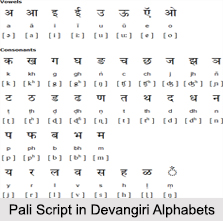 Pali language is a branch of the Indo-European family of languages, mainly of Europe, Iran and northern India. Inside this family, it belongs to the Indo-Aryan languages, which is called Prakrits in Indian linguistic works. Emperor Ashoka erected a number of pillars to engrave his edicts on them, for which he used at least three regional Prakrit languages in Brahmi script. All of the languages are quite similar to Pali language. Pali is considered to be one of the oldest Prakrits. Pali scripts are written in different types of alphabets, among which the most popular ones are Sinhalese, Burmese and Kambodian etc. All these types of alphabets have been derived from the Acoka Alphabet, which was used in the ancient inscriptions of India. The transmission of written Pali has retained a universal system of alphabetic values. But it has expressed those values in a stunning variety of actual scripts.
Pali language is a branch of the Indo-European family of languages, mainly of Europe, Iran and northern India. Inside this family, it belongs to the Indo-Aryan languages, which is called Prakrits in Indian linguistic works. Emperor Ashoka erected a number of pillars to engrave his edicts on them, for which he used at least three regional Prakrit languages in Brahmi script. All of the languages are quite similar to Pali language. Pali is considered to be one of the oldest Prakrits. Pali scripts are written in different types of alphabets, among which the most popular ones are Sinhalese, Burmese and Kambodian etc. All these types of alphabets have been derived from the Acoka Alphabet, which was used in the ancient inscriptions of India. The transmission of written Pali has retained a universal system of alphabetic values. But it has expressed those values in a stunning variety of actual scripts.
Pali in Different Alphabets
In Sri Lanka, Pali texts have been recorded in Sinhala script, Burmese script in Myanmar and Khmer script for Cambodia, Thai script for Thailand, Brahmi, Kharosthi and Devanagari scripts for India. Later, when western scholars began to learn about Buddhism, they started to use Roman characters to write Pali language.
Pali Alphabetical Order
Pali alphabetical order is - a ā i ī u ū e o (U+1E43) k kh g gh (U+1E45) c ch j jh ñ (U+1E6D) (U+1E6D)h (U+1E0D) (U+1E0D)h (U+1E47) t th d dh n p ph b bh m y r l (U+1E37) v s h (U+1E37)h.
Phonology of Pali
For vowels, there are two types- long and short vowels. In open syllables the long and short vowels are always contrastive. For closed syllables, all vowels are always short. The consonants are both in labiodental and bilabial.
This article is a stub. You can enrich by adding more information to it. Send your Write Up to content@indianetzone.com



















